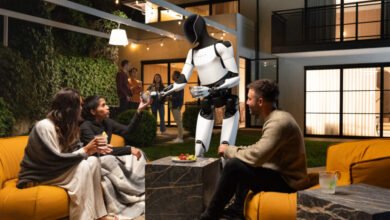Meta’s Next Big Bet: Humanoid Robots

▼ Summary
– Meta is making a multi-billion dollar “AR size bet” on building humanoid robots, according to CTO Andrew Bosworth.
– The primary challenge is not the hardware but the software, specifically the difficulty of dexterous manipulation for tasks like picking up objects.
– Meta’s strategy is to license its software platform to other robot manufacturers, similar to Google’s approach with Android, rather than focusing on hardware production.
– The effort is being supported by Meta’s new Superintelligence AI lab, which is working to build a “world model” and the necessary datasets for robotic spatial awareness.
– Bosworth expressed skepticism about Tesla’s data-driven approach for Optimus, questioning how it would acquire sufficient real-world data for humanoid robots.
Meta is placing a massive strategic wager on the future of humanoid robotics, viewing it as an investment on par with its augmented reality ambitions. According to a senior executive, the company is preparing to commit billions of dollars to this new frontier. The initiative, directed by CEO Mark Zuckerberg, is being spearheaded by Chief Technology Officer Andrew Bosworth, who established a dedicated robotics research team earlier this year.
In a recent discussion, Bosworth pinpointed the central challenge facing humanoid robots. He believes the hardware, while difficult, is not the primary obstacle. The real bottleneck is the software. To illustrate his point, he used a simple example: picking up a glass of water. While robots can perform complex maneuvers like backflips on stable ground, the dexterity required for delicate manipulation, avoiding crushing the glass or spilling the water, remains an immense software problem.
Internally, the project is known as “Metabot,” but Meta’s ultimate goal is not necessarily to become a hardware manufacturer. Instead, the company plans to adopt a strategy similar to Google’s Android model. The vision is to develop a powerful software platform that can be licensed to other robot manufacturers. Bosworth explained that Meta would provide the software blueprint for any company to use, provided their robots meet certain specifications.
This software effort is deeply connected to Meta’s new Superintelligence AI lab. The two groups are collaborating to build a sophisticated “world model.” This model aims to provide the AI with the spatial awareness and simulation capabilities needed to animate a dexterous hand. A significant hurdle is creating the necessary data set, as the “sensor loop” for a robot to perform a nuanced task, like retrieving keys from a pocket, does not yet exist. Bosworth emphasized that this new AI lab, led by ex-Scale CEO Alexandr Wang, is fundamental to their confidence in tackling the problem.
When comparing approaches, Bosworth expressed skepticism about the path Elon Musk is taking with the Tesla Optimus robot. He questioned how Tesla would gather the vast amount of real-world data required for training, a challenge he sees as more straightforward for self-driving cars than for general-purpose humanoids.
Meta has assembled a team of notable experts to lead the charge. Marc Whitten, former CEO of the self-driving company Cruise, heads the robotics team. The company has also recruited top talent like Sangbae Kim from MIT, whom Bosworth described as “the greatest tactical roboticist in the game.” The team also includes senior engineers like Jinsong Yu and veteran Ning Li, who is leading the engineering efforts.
Despite the ambitious investment, Bosworth indicated that Meta’s strategy is still taking shape. The company is evaluating different silicon providers, such as Nvidia and Qualcomm, who are competing to be the hardware backbone for humanoids. He also suggested that Meta’s initial goals may be more pragmatic than those of competitors, noting that a robot hand doesn’t necessarily need extreme complexity. “I don’t think you need 23 degrees of freedom in your hand. Two thumbs would be nice. I only need two thumbs,” he remarked, signaling a focus on practical, achievable dexterity.
(Source: The Verge)





